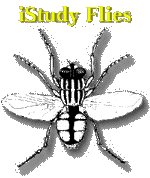|
iStudy Flies - Flies in General: Form and Function
FLIES IN GENERAL
Form and Function
The body of the fly consists of: (1) head, (2) thorax, and (3) abdomen. The head
houses the brain,  antennae, eyes, and mouthparts.
A sticky liquid is secreted by the pulvilli -- hairy pads on each of its six legs
-- allowing the fly to cling or run upside down. [22] True flies have one pair of flying
wings, but also have a tiny set of knobbed organs called halteres or balancers for
in-flight stability. The halteres vibrate in synchronization with the wings; and,
when the pitch, yaw, or roll of the fly changes, the halteres gyroscopically send
signals to correct its flight attitude. Most flies have eyes that constitute most
of the surface area of the head, but some parasitic flies have no eyes at all. While
flies suck their food, there appears to be a few flies that do not feed as adults.
Whether short horn or long, whiplike antennae (plural; antenna, singular),
most all flies have antennae. The adult female biting midge, mosquito, and black
fly must have blood protein from their host to supplement larval nutrition, without
which their eggs cannot be laid. [23] antennae, eyes, and mouthparts.
A sticky liquid is secreted by the pulvilli -- hairy pads on each of its six legs
-- allowing the fly to cling or run upside down. [22] True flies have one pair of flying
wings, but also have a tiny set of knobbed organs called halteres or balancers for
in-flight stability. The halteres vibrate in synchronization with the wings; and,
when the pitch, yaw, or roll of the fly changes, the halteres gyroscopically send
signals to correct its flight attitude. Most flies have eyes that constitute most
of the surface area of the head, but some parasitic flies have no eyes at all. While
flies suck their food, there appears to be a few flies that do not feed as adults.
Whether short horn or long, whiplike antennae (plural; antenna, singular),
most all flies have antennae. The adult female biting midge, mosquito, and black
fly must have blood protein from their host to supplement larval nutrition, without
which their eggs cannot be laid. [23]
Since the female blowfly is capable of laying one to two thousand eggs, it would
be a great calamity to sheep ranchers, if more than a few of the blowfly larvae (maggots)
survived to emerge as adult sheep blowflies. [24] Blowflies such as the sheep blowfly
of Australia are very effective in the role of accelerating the breakdown of the
bodies of dead sheep and returning their nutrients to the ground; however, the opportunistic
sheep blowflies have been so successful that they have been breeding on live sheep,
resulting in deaths, lost production, and treatment costs of over $100 million per
year. [25] Environmental controls are the most effective for the control of flies,
e.g., clearing of brush habitat, but control by insecticide or the release of natural
parasites is normally needed to further reduce the fly population. For example, if
sterilized male tsetse flies -- which have been exposed to gamma radiation in the
laboratory -- are released to mate, they not only will produce no offspring, but
the female tsetse fly, which breeds only once, is then rendered effectively sterile.
Thus, a treated area becomes totally eradicated of tsetse flies. [26]
|

